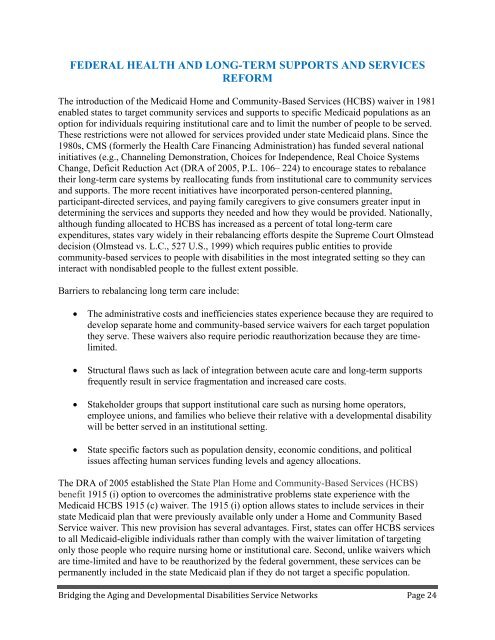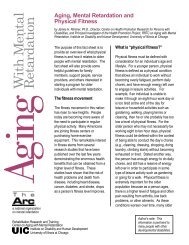Bridging the Aging and Developmental Disabilities Service ... - rrtcadd
Bridging the Aging and Developmental Disabilities Service ... - rrtcadd
Bridging the Aging and Developmental Disabilities Service ... - rrtcadd
Create successful ePaper yourself
Turn your PDF publications into a flip-book with our unique Google optimized e-Paper software.
FEDERAL HEALTH AND LONG-TERM SUPPORTS AND SERVICES<br />
REFORM<br />
The introduction of <strong>the</strong> Medicaid Home <strong>and</strong> Community-Based <strong>Service</strong>s (HCBS) waiver in 1981<br />
enabled states to target community services <strong>and</strong> supports to specific Medicaid populations as an<br />
option for individuals requiring institutional care <strong>and</strong> to limit <strong>the</strong> number of people to be served.<br />
These restrictions were not allowed for services provided under state Medicaid plans. Since <strong>the</strong><br />
1980s, CMS (formerly <strong>the</strong> Health Care Financing Administration) has funded several national<br />
initiatives (e.g., Channeling Demonstration, Choices for Independence, Real Choice Systems<br />
Change, Deficit Reduction Act (DRA of 2005, P.L. 106– 224) to encourage states to rebalance<br />
<strong>the</strong>ir long-term care systems by reallocating funds from institutional care to community services<br />
<strong>and</strong> supports. The more recent initiatives have incorporated person-centered planning,<br />
participant-directed services, <strong>and</strong> paying family caregivers to give consumers greater input in<br />
determining <strong>the</strong> services <strong>and</strong> supports <strong>the</strong>y needed <strong>and</strong> how <strong>the</strong>y would be provided. Nationally,<br />
although funding allocated to HCBS has increased as a percent of total long-term care<br />
expenditures, states vary widely in <strong>the</strong>ir rebalancing efforts despite <strong>the</strong> Supreme Court Olmstead<br />
decision (Olmstead vs. L.C., 527 U.S., 1999) which requires public entities to provide<br />
community-based services to people with disabilities in <strong>the</strong> most integrated setting so <strong>the</strong>y can<br />
interact with nondisabled people to <strong>the</strong> fullest extent possible.<br />
Barriers to rebalancing long term care include:<br />
• The administrative costs <strong>and</strong> inefficiencies states experience because <strong>the</strong>y are required to<br />
develop separate home <strong>and</strong> community-based service waivers for each target population<br />
<strong>the</strong>y serve. These waivers also require periodic reauthorization because <strong>the</strong>y are timelimited.<br />
• Structural flaws such as lack of integration between acute care <strong>and</strong> long-term supports<br />
frequently result in service fragmentation <strong>and</strong> increased care costs.<br />
• Stakeholder groups that support institutional care such as nursing home operators,<br />
employee unions, <strong>and</strong> families who believe <strong>the</strong>ir relative with a developmental disability<br />
will be better served in an institutional setting.<br />
• State specific factors such as population density, economic conditions, <strong>and</strong> political<br />
issues affecting human services funding levels <strong>and</strong> agency allocations.<br />
The DRA of 2005 established <strong>the</strong> State Plan Home <strong>and</strong> Community-Based <strong>Service</strong>s (HCBS)<br />
benefit 1915 (i) option to overcomes <strong>the</strong> administrative problems state experience with <strong>the</strong><br />
Medicaid HCBS 1915 (c) waiver. The 1915 (i) option allows states to include services in <strong>the</strong>ir<br />
state Medicaid plan that were previously available only under a Home <strong>and</strong> Community Based<br />
<strong>Service</strong> waiver. This new provision has several advantages. First, states can offer HCBS services<br />
to all Medicaid-eligible individuals ra<strong>the</strong>r than comply with <strong>the</strong> waiver limitation of targeting<br />
only those people who require nursing home or institutional care. Second, unlike waivers which<br />
are time-limited <strong>and</strong> have to be reauthorized by <strong>the</strong> federal government, <strong>the</strong>se services can be<br />
permanently included in <strong>the</strong> state Medicaid plan if <strong>the</strong>y do not target a specific population.<br />
<strong>Bridging</strong> <strong>the</strong> <strong>Aging</strong> <strong>and</strong> <strong>Developmental</strong> <strong>Disabilities</strong> <strong>Service</strong> Networks Page 24



